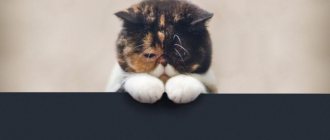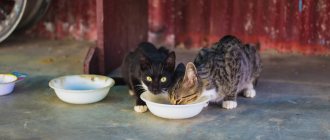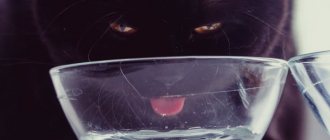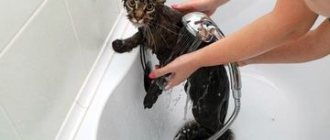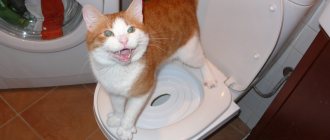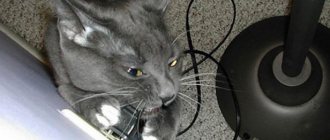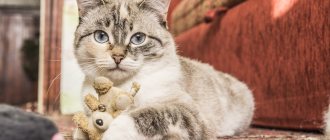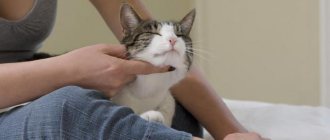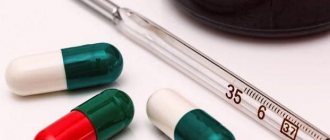At what age do kittens start eating on their own?
In the first days of life, babies are breastfed and do not require special human care. Nutrition problems fall on the mother cat.
Little kittens are completely helpless, so the owner should be patient and pay special attention to how and what to feed the baby correctly
After 3 weeks, she will need the help of her owner, because the kittens are already becoming more active and independent, moving around the house, learning to go to the toilet.
From this moment on, the cubs are weaned from their mother's milk.
Important! Until about one month of age, kittens should be fed low-fat milk up to 8 times a day.
Features of feeding kittens at different ages
Pets aged 1-1.5 months are fed liquid food at least 5-6 times a day, the following dishes are suitable:
- Puree (vegetable or meat);
- liquid unsweetened semolina porridge;
- skim cheese;
- boiled yolk.
At 2 months, the animals have their baby teeth and can now be fed solid food. But it is impossible to exclude liquid food, since it is necessary for the proper functioning of the digestive system.
As an animal grows, its need for food and nutrients increases.
At 2 months you can already give the following food:
- lean boiled meat;
- cottage cheese;
- chicken yolk;
- milk;
- yogurt.
Be sure to read:
The cat constantly asks for food: normal or pathological, reasons, what to do, whether it is necessary to limit food
Food should be rich in vitamins and nutrients. From childhood, teach your pet to eat cereals and vegetables in addition to milk, fish and meat.
Where to start teaching a cat to eat food?
Dry food granules can be given to a kitten from the age of 2.5 months. Previously, the baby’s body is not yet formed for a complete transition to a different diet. Moreover, it is important to know that they are not given immediately. To ensure that the retraining process is as comfortable as possible for the animals and does not cause problems with the digestive system, veterinarians recommend:
- The first acquaintance with new food can begin during the game. You can offer it to the kitten as a treat to create pleasant associations. But sometimes this stage is missed and they start with soaking or adding complementary foods to the main dish;
- To begin with, the granules will need to be given not in their pure form, but added to food. Gradually the ratio of dry food should increase. This transition is designed for 10-14 days;
- The industrial diet can be introduced separately from the main meal. To do this, it is soaked in water. Moreover, the liquid must be boiled or purified. Do not use milk or broths as they may be difficult to digest when combined with food. The consequence may be diarrhea. When the owner gives a bowl of food, he must make sure that the pellets are soaked to the desired state. For this result, you need water cooled to 40°C. Soak the food for 20-30 minutes;
- When giving your cat wet food, make sure it doesn't sit in the bowl for too long. It can be stored in the refrigerator for no more than 12 hours.
How to feed a newborn kitten
Nothing can replace breastfeeding for a baby, but if a kitten is weaned from its mother early, it will have to do without mother's milk.
Without mother's milk
Nothing can replace breastfeeding for a baby.
Once born, the baby should receive food 8 times a day. Low-fat milk is heated to 37 ° C and the newborn is fed from a pipette. In addition, water should be present in the diet.
At three weeks of age, you need to switch to a bottle with a nipple. After eating, massage your baby's belly to improve digestion.
Regular food
Choose food that contains vitamins and microelements necessary for the growth and development of the animal.
Suitable for the diet:
- Liquid milk porridges;
- Milk, cottage cheese;
- Boiled chicken or other lean meat, fish.
Gradually introduce dry food into your pet's diet. For young kittens you need to select special baby food.
When to see a doctor
In some cases, an animal’s refusal to drink water is due to various diseases. Associated symptoms here may be lethargy and apathy. If poisoned, the animal may suffer from diarrhea or vomiting.
Let's summarize: for full development it is important that the kitten consumes enough water. If there is a problem in getting used to drinking plain water from a bowl, it is important to understand the cause. If the baby has not yet learned the ability to drink properly from his mother, he needs to be taught how to do it. If the kitten does not like the quality of the water, it is worth observing its preferences and making the necessary changes, and in case of dehydration caused by illness, it is necessary to visit a veterinarian and undergo a course of treatment in accordance with his recommendations.
How to tell if a kitten is hungry
You can guess that an animal is hungry by its behavior. The first thing that gives away is the look. If your pet looks at you for a long time and incessantly, then it’s time to feed him. Loud meowing is also a signal that it is time for lunch or dinner.
If a cat repeatedly runs up to the bowl or to the place where it is fed and runs back, then this is also a hint that it is hungry. Some animals sometimes scrape their cup with their paws.
In order for the kittens to get used to the diet, the owner must remove the leftover food after a meal, then they no longer try to beg for a treat.
How to create the right conditions
Often, owners are faced with a situation where a kitten drinks water, but not where the bowl was placed. In the right place, the liquid remains untouched, and the pet has adapted to drink water from the tap, in the toilet or other place. Understanding the reasons will allow the owner to change the situation and teach the kitten to drink where it should:
- From early childhood to old age, cats are considered clean creatures. Therefore, they are disdainful of drinking water if it is poured into dirty dishes or if it sits there for a long time. This is one of the reasons why you should not place water near food. This way, drinking liquid becomes contaminated much faster. And the animal is unlikely to want to drink it.
- Cats react quite acutely to odors. Low-quality raw materials can not only have a color or smell that is unattractive to your pet, but also release toxic substances into the water. Therefore, if the bowl is made of cheap and low-quality material, the kitten may refuse to drink from it altogether. Moreover, such liquid becomes dangerous to his health.
- Sometimes the reason why an animal refuses water can be due to the increased content of chlorine in it. If this happens, you should replace the tap water with settled or filtered liquid.
How to train kittens to eat on their own
Animals at the age of 3 weeks already show interest in the food of adult cats . This is a good time to start complementary feeding and teach your baby to eat from a saucer.
Be sure to read:
Cats have mats, what they are + video on how to get rid of hair that has gotten into a ball
How to accustom a kitten to a bowl?
To do this, pour a small amount of warm milk into a saucer, wet your finger and let the kitten lick it. Afterwards, place the baby near the bowl and gently poke his muzzle into the milk.
Animals at the age of 3 weeks already show interest in the food of adult cats
At first, the kitten may sneeze or snort or blow bubbles, but over time he will adapt to lapping from the bowl. If your pet tries to climb into the saucer with its legs, then immediately prohibit it in order to accustom it to order.
Sometimes the pet refuses to eat on its own. The reason is that he was weaned from breastfeeding prematurely. In this case, it is better to give the baby food from a pipette again or return him to his mother and try to repeat the training after a while.
How to accustom a kitten to a change in diet?
The menu should be varied. Teaching a kitten to eat something new is not that difficult.
Follow the recommendations:
- New products are added gradually.
- Small portions of a new product for the kitten are mixed with the usual food.
- If your pet does not immediately try the unusual food, then it is better to feed it by hand.
- If the cat refuses this food, then it is better not to insist and try to introduce something else into the menu.
What can and cannot be given to a kitten?
In order for your pet to grow strong and healthy, nutrition must be balanced. Be sure to include fish or lean meat, dairy products, and cereals in your diet. Consult your veterinarian for vitamin supplements.
Important! Fatty meats, sweets, flour dishes, raw fish, and smoked foods are contraindicated for cats.
How to switch your pet to homemade food
When purchasing a kitten, a person is usually interested in the baby’s habits and preferences, including gastronomic ones. After all, kittens that are already grown up most often end up in a new home from a breeder; they feed not on mother’s milk, but on real food or feed. How to switch a new pet to a different diet and do it as painlessly as possible? The training process is carried out according to the rules:
- During the adaptation period, when the cat is just getting accustomed to a new place, it is not advisable to experiment with the diet. It is worthwhile to feed him for the first time in the same way as the breeder did - the baby does not need unnecessary stress.
- It is recommended to carry out the transfer gradually. Initially, a small amount of food is added to the usual diet. Then its volume increases and, finally, the bowl contains only food that is new to the cat.
- You can start by adding a wet diet to the kibble. Later, the pate is mixed with natural products and gradually the industrial diet is removed from the menu.
- When a dry diet is completely excluded from the menu, it cannot be given to your pet subsequently, even as a treat. You should not provoke the cat.
- As practice shows, kittens quickly get used to a different type of feeding, which cannot be said about adult animals. It turned out that by demonstratively turning away from the bowl, cats are not being mischievous and are not showing character. Often they are concerned about the manifestations of dependence on dry food. But this does not mean that the animal will die of starvation if it does not receive the usual pellets.
Duration of transition from one type of feeding to another.
The average period for transferring a cat from dry food to natural food is one week.
At first, your pet may turn up its nose at the bowl. Then you should calmly remove it and place it with a fresh portion of food during the next feeding.
Taking care of your pet's health. In order for the animal’s digestive tract to function fully even during changes in the type of food, it is recommended to give the pet probiotic preparations: Bifitrilak, Enterol, Zoonorm, Subtilis.
Probiotics can also be purchased at a regular pharmacy - Bifidumbacterin, Normobakt, Linex.
A few necessary recommendations
It is difficult for your kitten to feed himself if the dishes are awkward or large, so you should choose dishes that are the right size and that are stable on the floor. This way the baby will feel more comfortable and will eat more willingly.
Be sure to read:
A kitten meows: reasons, how to quickly calm it down, what to do when you need veterinary help
Don't forget the following simple rules:
- A saucer of water should be placed near the bowl of food.
- You cannot force a kitten to eat.
- Do not mix dry food with regular food. This can only be done when switching from one food to another.
On a note! The kitten will refuse food that is too hot or, on the contrary, cold . Food should be at room temperature.
Irreparable harm to health from dry food
Such food can cause a lot of problems, the most common of which include:
- vitamin deficiency – many dry foods do not contain sufficient quantities of certain vitamins that are so necessary for the pet and which are found in homemade food;
- dysbacteriosis – beneficial bacteria die in the stomach, and a disorder occurs;
- poisoning – your pet can be poisoned by various dyes that the food contains;
- heart and kidney diseases - since this food contains a lot of salt, the kidneys may be the first to suffer from it, because it is difficult for them to excrete them. Poor kidney function will, in turn, provoke heart failure;
- allergies – ulcers may appear in the animal’s mouth or hair may begin to fall out;
- cancer - most types of food contain monosodium glutamate, which is known to cause tumors.
To avoid this kind of trouble, you need to teach your cat to eat regular food.
© shutterstock
Common mistakes when changing feeding methods
Common mistakes that cat owners make when changing the way they feed them:
- Abrupt transfer from one food to another. There is no need to rush in this situation. A smooth transition from the usual to a new type of food will allow your pet to avoid problems with digestion and stool. Ideally, this process should take about 1.5 weeks.
- Concession to blackmail from a four-legged pet. Almost all animals protest against changes in diet, refusing to eat and begging for their favorite food.
- Long-term ignoring of a cat's hunger strike. It is important not to miss the moment when fasting will harm the four-legged blackmailer.
- Application of physical methods. When forcing your pet to eat natural foods, you cannot shout at him or hit the animal. This will cause him severe emotional distress.
- Leaving self-prepared food in a cat's bowl for a long time. If within half an hour the cat has not touched the contents of the bowl, it is recommended to throw it away, otherwise it will spoil and the pet will be poisoned.
Ways to teach people to drink water
It is not recommended to forcefully poke your muzzle into the bowl. Such actions will frighten the animal, and it will refuse to lap for a long time. If the kitten does not drink water at all, what should you do in this case? There are several ways to teach it.
Outdoor games will make you thirsty
Active games
During movement, fluid loss increases. It's time to put a bowl of water in a visible place. There is another way to get used to drinking water. You should wet the animal’s nose with a drop of water or milk, it will definitely start licking and drinking.
Homemade cat food
If you decide to switch your cat to normal homemade food, then you should not do it suddenly. A change in diet can negatively affect the behavior of the animal itself, provoke problems with the gastrointestinal tract and other problems, ranging from teary eyes and dry mouth mucosa to hair loss. Feeding changes should be done in stages.
Table of nutritional norms for an adult cat.
Tricks to attract water
Those owners whose cats suffer from urolithiasis should be the most successful than others. Not everyone knows how to get a cat to drink water if they have urticaria. A small trick that can help with this is purchasing a special drinking fountain. Some cats really enjoy drinking running water that comes out of a faucet. A small drinking fountain will become your furry pet's favorite device.
You can use catnip to highlight your new water bowls. The animal will not remain indifferent to the tempting smell and will go to explore its territories. How to get your cat to drink water using catnip? You just need to blot a small cloth with liquid catnip and place a container of water on top. Such a bowl should be in every room where your pet has access.
Monosodium glutamate is one of the causes of addiction
The food additive E621, which is a flavor enhancer, is included in most dry diets intended for feeding pets:
- This component not only gives the product an unnatural taste, but also irritates the taste buds.
- Cats get used to the rich taste and aroma of granules, so natural food does not arouse their interest.
- Refusing the “correct” food, the pet will use all its charms, begging for familiar food and treats. It is important for the owner not to give up at this moment.
The fact that monosodium glutamate is very harmful to the animal’s body and can cause the development of cancer pathologies will help strengthen the owner’s willpower.
Also watch the video on how to wean a cat off food:
Reasons for refusing to eat
A small kitten refusing to eat is always a very serious cause for concern. The baby requires examination by a veterinarian, who is called to the house. In newborn kittens, the cause may be:
- Disorders of intrauterine development.
- Injuries received during childbirth, as well as from being crushed by an inexperienced cat.
- Low birth weight due to placental insufficiency in the cat - such kittens must be supplemented artificially, otherwise they will die.
- Intrauterine infection, for example, with chlamydia or feline leukemia virus.
- Hypothermia (low body temperature) - when keeping a cat and kittens in a cold room, and especially when raising kittens without a cat. If you have hypothermia, you cannot feed your kitten because its digestive system is not functioning. The baby is gradually warmed up by giving him a solution of pedialyte or a 5% glucose solution at the rate of 1 ml of solution per 30 g of the kitten’s weight per hour, achieving active movements in the kitten. Hypothermia is very dangerous, so you should maintain the temperature in the den at 29–32 °C, reducing it every week by 2.5 °C until it reaches 21 °C. To warm the den, lamps are placed above it, and heating pads are also used. This is usually necessary if there is no cat or she refuses to be with the kittens.
- Neonatal isoerythrolysis (hemolysis of newborns) is a condition when antibodies obtained from a cat's colostrum attack the kitten's red blood cells, resulting in the development of jaundice. The kitten can be saved by transferring it to artificial feeding for 2 days, and then returning it to the cat. The condition is caused by a mismatch in the blood groups of a cat and a kitten; its analogue is Rh conflict in humans. The difference is that in primates, the transfer of antibodies occurs through the placenta, and the course of Rh conflict is intrauterine. In cats, the transfer of antibodies occurs with milk, so this condition is easier to suppress, since the penetration of maternal antibodies into the blood through the intestinal wall of the kitten is possible only in the first 24 hours of its life.
In kittens that previously developed normally, the reason for refusing to eat may be:
- helminthic infestation;
- infection;
- in some cases, when solid food is introduced and there is a lack of drinking water, the kitten may experience constipation, which reduces appetite.
The cat does not eat enough food for sterilized animals - is it possible to give regular food?
RESPONSE OF THE SITE “MURKOTIKI”
Neutered cats, in order to feel full, must, among other things, feel a full stomach, because... hormonal regulation of appetite works less well for them. Industrial feeds are made in such a way that the stomach does not work enough to digest them: everything slips into the intestines too quickly when compared with eating raw meat. And food for sterilized animals includes very little meat and a huge amount of plant components, often cereals, which are not recommended for cats at all. Not only are they hardly digestible, but they also interfere with the absorption of nutrients from other foods. Result: the cat feels hungry due to the rapid emptying of the stomach and due to the fact that there are practically no useful substances of animal origin in the food for castrates - there is simply nothing to absorb, these are dummies. Look at the percentage of meat: if it is not indicated or low (less than 70%), and the manufacturer is silent about the origin of plant and animal proteins and the composition contains grain, such food is not healthy.
If the cat is not overweight, we do not recommend using castrate food. Feed the cat fully, let him eat. If you start to overeat and gain excess weight, then you will adjust your diet. But in any case, how much to feed the cat depends on you: if you feed the norm, the weight will be normal.
What to replace insufficiently nutritious food with? The first option is more nutritious. But the MURKOTIKI website has analyzed a lot of super-premium food and cannot recommend a single composition with confidence. And the appetite with which a cat absorbs this or that food often does not depend in any way on its quality. As a rule, cats like low-level food, because... Attractants are generously added to them - substances that attract with their smell and force them to eat even inedible things. The higher the quality of the food, the fewer flavors it contains (or none at all) - and the more difficult it is to treat the animal with it, that is, the cat can completely refuse good food, but gobble up low-quality food on both cheeks. And the advice of sellers in this matter is in the category of “let the cat eat what he likes” - this is the last thing you need to listen to. Sellers always know the answers to all questions, without actually knowing anything. It is clear that the seller will tell you to give you what the cat agrees to eat, and thus get a regular customer. Often would-be sellers recommend economy-class food or premium food that is slightly superior in quality. Moreover, the label may say that they are super-premium, but this is only a marketing ploy. Food must be chosen, first of all, according to its composition.
Now about the condition of the coat. On any food, even economy food, a cat may stop shedding if increased hair loss was associated with a lack of vitamins. But only because the composition is artificially fortified. Before this, the cat apparently ate non-vitaminized food and did not regularly take courses of vitamins, which led to increased shedding of fur. But if you continue to constantly feed a composition with vitamins in an unknown quantity, hypervitaminosis may begin - a condition that is sometimes more dangerous than hypovitaminosis. The problem of lack of vitamins and minerals should be solved not by choosing low-quality food, but in another way.
The second option is natural nutrition. With the right natural diet, the cats' weight returns to normal, they do not overeat and do not remain hungry. The muscles become stronger and more defined, and the coat noticeably improves if there were problems before. Of course, natural nutrition requires additional effort on the part of the owner.
As for weight, the ideal build of a cat is determined by eye. A separate article on the site provides a table to help you navigate. For the approximate weight of Scottish cats of different ages, see.
Complete diet for cats
Before starting to feed your pet homemade food, it is advisable for the owner to consult with a veterinarian. You can also independently familiarize yourself with the list of products that belong on the menu of domesticated cats:
- Meat . It should form the basis of the animal's diet. It is recommended to give it raw. And since meat products can be infected with parasites, they should be frozen before serving, and the thawed slices should be scalded with boiling water. Pork and lamb are not suitable for feeding cats; it is better to feed them beef, veal, turkey, horse meat, rabbit, and chicken.
- Fish . This product is given to pets 2-3 times a week, after boiling and removing the bones. It is better to give preference to oceanic and sea species, but it is better to exclude river species from the menu.
- Vegetables . Carnivores, which cats are, also need plant foods containing healthy fiber. Pumpkin, carrots, broccoli, zucchini, and spinach are most suitable for these purposes. You can treat your pet to cucumber, beets, and bell peppers. It is important to consider that not all vegetables are healthy for cats and should not be fed to them: cabbage (causes flatulence), potatoes (contains a large amount of starch), radishes (disturbs digestion). It is advisable to give vegetables boiled, except for cucumbers and spinach.
- Cereals . Rice, especially brown rice and buckwheat, are the most suitable cereals for feeding cats. You can also boil oats and pearl barley. But veterinarians do not recommend giving semolina to pets; it contains a lot of carbohydrates and can cause obesity.
- Milk and fermented milk products. Adult cats are not given whole milk; it is only suitable for kittens. But it is undesirable to feed both of them with sour cream, heavy cream, and yoghurts with additives. Twice a week you can give your pet natural yogurt, kefir, yogurt, and low-fat cottage cheese.
What should you give your cat to keep it healthy?
To provide your pet with all the necessary elements, its diet must contain the following components:
- proteins obtained from meat, dairy products, fish, eggs - 45%;
- offal – 20%;
- fiber, the sources of which should be vegetables, fruits, herbs, cereals - 20%;
- vitamin and mineral complexes, vegetable oil, bone meal – 5%.
Special food for cats, even from the most famous manufacturers, is addictive to the animal. But sometimes there are situations when the cat itself refuses dry food. Or, for example, you moved to a rural area where there are no special stores with cat food. And here the question arises, how to transfer the animal to a new diet and replace dry food with normal homemade food, but at the same time leave the pet’s nutrition balanced?
